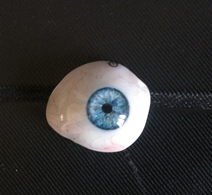
Ocular Prosthesis
Artificial Eyes or Ocular Prosthesis
An artificial eye is an ocular prosthesis that is worn full-time, restoring the volume and appearance of a missing eye. With advanced techniques, we focus on matching contours and folds of the eye lids, amount of movement and color of the natural eye to create a life-like artificial eye..
History of Artificial Eyes
The art of making artificial eyes has been practiced since ancient times. In those days, During the times of 5th B.C artificial eyes were made of enameled metal or painted clay and attached to cloth and worn outside the socket infront of the eyelids. The same artistic skills had been applied to death masks at a still earlier date, around 2000 BC.
Egyptian Mummy Eyes
The eyes on those masks found associated with Egyptian mummies, often made of plaster-filled bronze for cosmetic replacements. A maker of these eyes were called as faber ocularius, which we should regard as distinct from the medicus ocularius, i.e. he was a craftsman, not a medical practitioner.
16th Century Prosthesis
The eyes on those masks found associated with Egyptian mummies, often made of
plaster-filled bronze for cosmetic replacements. A maker of these eyes were called
as
faber ocularius, which we should regard as distinct from the medicus ocularius, i.e.
he
was a craftsman, not a medical practitioner.
he Venetian glass artisans discovered a formula that could be tolerated inside the
eye
socket. These early glass eyes were crude, uncomfortable to wear. But still Venetian
method was considered to be the finest in the World. We can observe that there was a
parallel development in the sixteenth century of artificial noses and ears, spurred
mainly by the injuries incurred when fighting a duel.
Artificial eyes are not for seeing, but are for being seen, being located smack in
the
middle of the face - the most visible part of the human body. Early false teeth were
also designed entirely for the sake of appearance
There were lot of improvements in techniques and materials during 17th Century and
the
Centre for artificial Eye was shifted to Paris. The French word Oculariste was given
to
the makers of Artificial Eyes.
In the mid-nineteenth century, glass artisans in Thuringia, a region in eastern
Germany,
developed a superior glass formula for the making of artificial eyes. The onset of
World
War II cut of the export of kryolite glass to the United States. With so many
injured
soldiers needing artificial eyes, the U.S. government searched for a replacement
material. Almost immediately the new plastics industry came to the rescue. Medical
plastics were already being used in the dental field before World War II. The
Department
of the Navy set up a crash course in applying plastics to the field of Ocularistry
that
lead to the development of medical grade acrylic plastic and its use in eye-making.
The
popularity of these materials and methods continued to increase over the years and
today
most of the people around the World use artificial Eyes, which were made of Acrylic
material.
Types of Ocular Prosthesis


Customized Ocular Prosthesis
Preparing eye shells for the patients according to their socket dimensions. In this type, even small details from normal eye will be given utmost attention to replicate the same in artificial eye.
Stock Eyes
Ready-made eye shells that are available in the market. This is manufactured as a mass product and these are available in random sizes, unlike Customized Ocular Prosthesis.

Indications for Artificial Eye

Phthisis Bulbi
Phthisis Bulbi is a Shrunken, non-functional eye. It may result due to several eye diseases, inflammations, injury or it may result as a complication of Surgery
Post Evisceration
During an Evisceration, the contents of the eye and the cornea are removed surgically, but the white layer (sclera) is retained.


Post Enucleation
Enucleation is the procedure used to remove diseased eye. During Enucleation, the entire Eyeball is removed.
Congenital Anophthalmia
It is the absence of one or both eyes by birth. In other words, it is a condition in which the entire globe and Intraocular tissues will be lost.
Microphthalmia
It is also referred as Microphthalmos. It is a developmental disorder of the eye in which one or both eyes are abnormally small and have anatomic malformations.
Fabricating a new artificial eye
There are two appointments required to make your new artificial eye. The first appointment lasts approximately 3 hours. At this appointment, an impression of your socket is taken, and a model of the shape is made. Once the best shape is achieved, the iris is hand painted to match your eye. Other details such as the sclera, veins and markings are matched in order to produce an eye that is accurate and has a natural appearance.
The second appointment takes place on the very next day. At this appointment, the eye is fitted. You will also be shown how to remove, clean and care for your prosthesis.
The procedure and appointments may get altered by your Ocularist, as per the severity of Sockets clinical condition.
When to fabricate a new artificial eye
We recommend that you have a new artificial eye made approximately every 4-5 years. Over time the shape of your socket changes, and your artificial eye may no longer fit as well as it did initially. Children and babies need their artificial eye replaced more frequently, approximately every 1-2 years. A correctly fitting prosthesis facilitates the normal development of the eye socket and eyelids
Insertion and Removal of Artificial Eye
Inserting and Removing Artificial Eye from its socket not a challenging task. Ocularist at Jaquest Artificial Eye Center will give you enough training on Insertion and removal of artificial eye, which is very similar to wearing a contact lens

Caring for your Artificial Eye
-
It is important to keep your artificial eye clean at all times. The first few times you do it you will probably be a bit nervous – most people are. You will soon find that you are able to do it simply and comfortably.
-
Never Clean or wash Artificial Eye with any alcohol. Instead clean the artificial eye with Luke-warm water or Mild Baby shampoo.
-
Never keep your artificial Eye in unnoticed place when you take it out from the socket for cleaning. Keep it in a safe and fixed place, so that your eye won’t get misplaced.
-
Consult your Ocularist for professional polishing of Artificial Eye Annually or Bi-annually
-
Consult your Ocularist for professional polishing of Artificial Eye Annually or Bi-annually
-
After you have worn your eye for some time it may start to feel “gritty” and uncomfortable, or you may notice that there is more discharge. This is quite normal and is caused by ordinary wear and tear. Consult your Ocularist, if there is significant discharge from the side of artificially fitted eye
-
Prosthetic eyes should not be removed and cleaned more frequently than monthly and not less than six months.
-
The more you remove artificial Eye from its socket, more the chances for infection will be, due to excessive wear and tear. So, it is advisable to clean artificial eye Bi-weekly or monthly.

Testimonials
“No Compromise in Quality Service”
My Occupation is Car Mechanic and I lost my Eye in an Injury and I heard about the quality service at Jaquest. Mr.Vasanth and his staff very clearly explained about the procedure of fitting Artificial Eye before starting the procedure and made me really feel comfortable, till the end of the procedure. The Artificial Eye (done elsewhere) which I had earlier used to pop out when I sneeze vigorously and that greatly hindered my confidence when I see my Customers. The results were amazing with Customized Artificial Eye and they ensured that my Artificial Eye is perfectly fitted. My heartfelt thanks for Jaquest Artificial Eye Center.

Mr.Parthiban

“Quality Patient care
I got artificial Eye fitted at Jaquest Artificial Eye Center. Though I am 65yrs old, still I didn’t find any discomfort or difficulty during the process of preparing artificial eye and every penny paid here, worth. Though I am Old, I still travel approx. 170kms for my regular evaluation of Artificial Eye and I find it worth and comfortable travelling all the way to Jaquest for their quality service.

Mrs.Rajalakshmi
Get in touch through
+91 - 888 00 39 000
Make an Appointment

copyright2022 All rights reserved